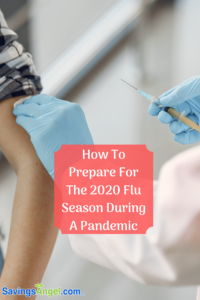How To Prepare For The 2020 Flu Season During A Pandemic
 According to the CDC, flu season in the U.S. is in the fall and winter, and peaks between December and February. What changes about the flu season and vaccine will come about as a result of the ongoing COVID-19 pandemic and how do we prepare? Not to worry, we’ve got you covered!
According to the CDC, flu season in the U.S. is in the fall and winter, and peaks between December and February. What changes about the flu season and vaccine will come about as a result of the ongoing COVID-19 pandemic and how do we prepare? Not to worry, we’ve got you covered!
Get Your Flu Shot
First and foremost, get your flu shot, and get it as early as possible. The CDC strongly recommends getting the flu vaccine this year, especially during the COVID-19 pandemic. This is an integral way to protect you and your loved ones’ health. Fewer and fewer people have kept up with vaccines and their immunization as a result of social distancing and stay-at-home orders, so if you skipped your flu vaccination over the summer, don’t wait. Get your flu shot. October will likely see a surge in those trying to get the vaccine, so getting it before lines start to form at clinics would be wise.
If you have questions or concerns about getting your flu shot during the pandemic, check out the CDC’s FAQ on the topic.
https://www.cdc.gov/flu/season/faq-flu-season-2020-2021.htm#anchor_1597410034241
Take Preventative Measures
With numbers of COVID-19 expecting to rise as temperatures cool during the fall and winter months, illness prevention and safety measures are as vital as ever. The CDC recommends staying away from those who are sick, covering your nose and mouth when you sneeze or cough (and if you’re wearing a mask, all the better), washing your hands frequently with soap and warm water, using hand sanitizer, and to avoid touching your eyes, mouth, and nose throughout the day.
Given that COVID-19 is still a concern to many, also remember to continue to wear a mask when you’re out and about. Many states and counties have mandatory mask orders, so be sure to be aware of what your county specifies.
No one wants to get the flu on top of COVID-19, so it’s super important that we continue taking illness prevention measures as we enter into the 2020-2021 cold and flu season.
Another great thing to do would be to take a bottle of hand sanitizer with you wherever you go and to wear gloves along with your mask. This may seem overboard to some, but with contagious illnesses, you can never be too careful.
Check out the CDC’s guide to preventative steps to take during the flu season to learn more.
https://www.cdc.gov/flu/prevent/prevention.htm
Do Your Research
Remember, there are those who should not get the flu shot. This includes children under 6 months of age or anyone with allergies to ingredients within the flu vaccine. Also, remember that sometimes after a flu shot, you can feel sick or under the weather for a few days. If the symptoms persist or get worse, you should talk to your doctor right away. Study up on all flu shot recommendations and guidelines before you go out and get one at your doctor’s office or local clinic.
This PDF is offered by the CDC and offers helpful dos and don’ts when it comes to the flu vaccine. https://www.cdc.gov/flu/pdf/freeresources/updated/who-should-vaccinate-update.pdf
Find Out Where You Can Get Your Flu Shot
Many pharmacies and clinics offer flu shots and immunization services nationwide. Check out their websites to find out where you and your family can get their flu shot. The best part? Flu shots are free with most medical insurance providers.


